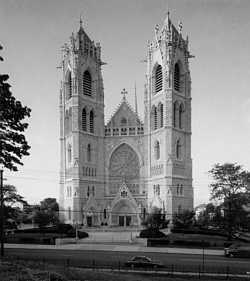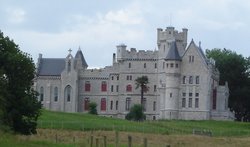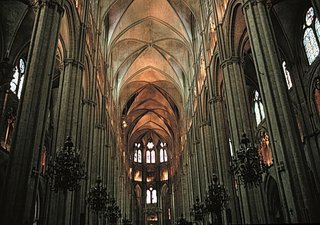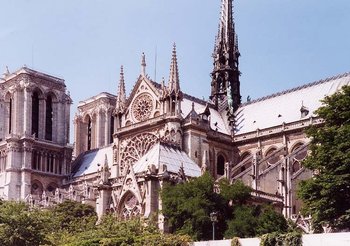Gothic architecture
|
|
- This article is about Gothic architecture. See also Gothic art.
Gothic architecture characterizes any of the styles of European architecture, particularly associated with cathedrals and other churches, in use throughout Europe during the high and late medieval period, from the 12th century onwards. It was succeeded by Renaissance architecture, a revival of Roman formulas, at varying times in Europe, beginning in Florence in the 15th century. A series of Gothic revivals began in mid-18th century England, triumphed in 19th century Europe and continued, largely for ecclesiastical and university structures, into the 20th century.
| Contents |
The term "Gothic"
Gothic architecture has nothing to do with the historical Goths. It was a pejorative term that came to be used as early as the 1530s to describe culture that was considered rude and barbaric. François Rabelais imagines an inscription over the door of his Utopian Abbey of Thélème, "Here enter no hypocrites, bigots..." slipping in a slighting reference to 'Gotz' (rendered as 'Huns' in Thomas Urquhart's English translation) and 'Ostrogotz.' In English 17th century usage, 'Goth' was an equivalent of 'vandal,' a savage despoiler, with a sense of 'Germanic' and so came to be applied to the architectural styles of northern Europe before the revival of antiquity, thus 'Gothic' architecture. "There can be no doubt that the term 'Gothic' as applied to pointed styles of ecclesiastical architecture was used at first contemptuously, and in derision, by those who were ambitious to imitate and revive the Grecian orders of architecture, after the revival of classical literature. Authorities such as Christopher Wren lent their aid in deprecating the old mediæval style, which they termed Gothic, as synonymous with every thing that was barbarous and rude., according to a correspondent in Notes and Queries No. 9. December 29, 1849.
Origins
The historical style itself originated at the abbey church of Saint-Denis in Saint-Denis, near Paris, where it exemplified the vision of Abbot Suger. Suger wanted to create a physical representation of the Heavenly Jerusalem, a building of a high degree of linearity that was suffused with light and color. The first truly Gothic construction was the choir of the church, consecrated in 1144. With thin columns, stained-glass windows, and an overall sense of verticality and etheriality, the choir of Saint-Denis established the elements that would later be amplified upon during the Gothic period. This style was adopted first in northern France and by the English, and spread throughout France, the Low Countries and parts of Germany and also to Spain and northern Italy.
Characteristics
The style emphasizes verticality and features almost skeletal stone structures with great expanses of glass, sharply pointed spires, cluster columns, flying buttresses, ribbed vaults, pointed arches using the ogee shape, and inventive sculptural detail. These features are all the consequence of a focus on large stained glass windows that allowed more light to enter than was possible with older styles. In order to achieve this, flying buttresses were used to enable higher ceilings and slender columns.
Gothic cathedrals could be highly decorated with statues on the outside and painting on the inside. Both usually told Biblical stories, emphasizing Old Testament prophecy and the New Testament (see Christian theology).
STmaximin-Solitude.jpg
Important Gothic churches could also be severely simple. At the Basilica of Mary Magdalene in Saint-Maximin, Provence (illustration, right), the local traditions of a sober massive Romanesque architecture were strong. The basilica, begun in the 13th century under the patronage of Charles of Anjou, was laid out on an ambitious scale (it was never completed all the way to the western entrance front) to accommodate pilgrims that came to venerate relics. Building in the Gothic style continued at the basilica until 1532.
In Gothic architecture new technology stands behind the new building style. The Gothic cathedral was supposed to be a microcosm representing the world, and each architectural concept, mainly the loftiness and huge dimensions of the structure, were intended to pass a theological message: the great glory of God versus the smallness and insignificance of the mortal being.
Gothic architecture in England
Fewer examples of secular structures in Gothic style survive. The "Old Palace" at Hatfield, 1497, is the entrance wing, with its imposing gatehouse, which gave access to the protected inner court. This is an example of the last phase of Gothic design in England, still untouched by the Renaissance under way in central Italy. Local building traditions informed a vernacular style that was as important as Gothic in the final appearance. The roofs are tiled in the East Anglian vernacular tradition. Substantial roofs enclose essential storage area in the spacious attics: the sight of such an expanse of roof evoked a sense of well-being and security. Gothic elements are the paired lancet windows joined under a molding that threw rainwater away from their sills, and the buttresses between each pier and on the angles of the gatehouse tower, with its fortification references.
Sequence of Gothic styles: France
The designations of styles in French Gothic architecture are as follows:
- Early Gothic
- High Gothic
- Rayonnant
- Late Gothic
These divisions are effective, but debatable. Because Gothic cathedrals were built over several successive campaigns, one not necessarily following the wishes of previous campaigns, the dominant architectural paradigm changes throughout a particular building. Consequently, it is often difficult to declare one building as a member of a certain era of Gothic architecture. It is more useful to use the terms as descriptors for specific elements within a structure, rather than applying it to the building as a whole.
Early Gothic:
- The East end of the Abbey Church of St Denis
High Gothic:
- Amiens Cathedral
- The main body of Chartres Cathedral
- Notre-Dame of Laon
- Notre Dame de Paris
- Reims Cathedral
Rayonnant:
- The nave of the Abbey Church of St Denis
Late Gothic:
Sequence of Gothic styles: England
The designations of styles in English architecture still follows conventions of labels given them by antiquaries in the 18th century:
- Early English (ca 1180 - 1275)
- Decorated (ca 1275 - 1380 )
- Perpendicular (ca 1380 - 1520 ).
Early English:
Decorated or "Flamboyant":
Perpendicular:
- Chapel of King's College, Cambridge

Gothic revival
Main article: Gothic revival
In England, some discrete Gothic details appeared on new construction at Oxford and Cambridge in the late 17th century, and at the archbishop of Canterbury's residence Lambeth Palace, a Gothic hammerbeam roof was built in 1663 to replace a building that had been sacked during the English Civil War. It is not easy to decide whether these instances were Gothic survival or early appearances of Gothic revival,.

In England in the mid-18th century, the Gothic style was more widely revived, first as a decorative, whimsical alternative to Rococo that is still conventionally termed 'Gothick', of which Horace Walpole's Twickenham villa "Strawberry Hill" is the familiar example. Then, especially after the 1830s, Gothic was treated more seriously in a series of Gothic revivals (sometimes termed Victorian Gothic or Neo-Gothic). The Houses of Parliament in London are an example of this Gothic revival style, designed by a major exponent of the early Gothic Revival, Augustus Pugin. Another example is the main building of the University of Glasgow designed by Sir George Gilbert Scott.
In France, the towering figure of the Gothic Revival was Eugène Viollet-le-Duc, who outdid historical Gothic constructions to create a Gothic as it ought to have been, notably at the fortified city of Carcassonne in the south of France and in some richly fortified keeps for industrial magnates (illustration, left). Viollet-le-Duc compiled and coordinated an Encyclopédie médiévale that was a rich repertory his contemporaries mined for architectural details but also also include armor, costume, tools, furniture, weapons and the like. He effected vigorous restoration of crumbling detail of French cathedrals, famously at Notre Dame, many of whose most "Gothic" gargoyles are Viollet-le-Duc's. But he also taught a generation of reform-Gothic designers and showed how to apply Gothic style to thoroughly modern structural materials, especially cast iron.
Gothic in the 20th Century
Gassonsummer.jpg
Neo-Gothic continued to be considered appropriate for churches and college buildings well into the 20th century. Charles Donagh Maginnis's early buildings at Boston College helped establish the prevalence of Collegiate Gothic architecture on American university campuses, such as at Chicago, Princeton and Yale. It was also used, perhaps less appropriately, for early steel skyscrapers.
Cass Gilbert produced his 1907 90 West Street building and the 1914 Woolworth Building, both in Manhattan, in a neo-Gothic idiom. It was Raymond Hood's neo-Gothic tower that won the 1922 competition for the Chicago Tribune Tower, a late example of the vertical style that has been called "American Perpendicular Gothic."
Another Gothic structure of interest is the jailhouse built in DeRidder, Louisiana in 1914. The iron bars in most of the windows give the structure an eerie appearance. The structure includes shallow arches, dormer windows and has a central tower. It is now on the National Register of Historic Places.
The last prominent Gothic architect in America was probably Ralph Adams Cram, working in the 1910s and 1920s. With partner Bertram Goodhue they produced many good examples, like the sensitive and clever French High Gothic St. Thomas Episcopal Church, New York with its asymmetrical, urban facade in the heart of Manhattan. Working alone, Cram took up the Cathedral of Saint John the Divine, what he meant to be the largest cathedral and largest Gothic struture in the world, again in French High Gothic. It remains unfinished. Both St. Thomas and St. John the Divine are built without steel.
List of notable Gothic structures

- France
- Chartres Cathedral
- Bourges Cathedral
- Bourges Cathedral (http://www.beloit.edu/~arthist/historyofart/gothic/bourges.htm)
- Amiens Cathedral
- Notre-Dame de Laon
- Our Lady's Cathedral in Paris (the Notre-Dame for many)
- Reims Cathedral (where all the kings of France were crowned)
- Abbey Church of Saint-Denis
- Sainte-Chapelle in Paris (famous for its colorful stained glass windows)
- England
- Spain
- Germany
- Cologne Cathedral
- Ulm Münster (features the highest church tower)
- Italy
- Ca' d'Oro, Venice
- Milan Cathedral, The Duomo
- Belgium
- Bruges City Hall, 1376—1420
- The Netherlands
- Austria
Torun-Rynek-ratusz-2.jpg
- Poland
- St Mary's Church in Gdańsk (the largest brick church in the world)
- St Mary's Church in Kraków (with the famous Veit Stoss altar carved in wood)
- Wawel Cathedral in Kraków
- City Hall in Toruń
- The Castle of the Teutonic Order in Malbork
- Slovakia
- Czech Republic
- Saint Barbara's Church in Kutná Hora
- Charles Bridge in Prague
- Croatia
- Russia
For a list of all Early Gothic buildings in the Paris Basin, http://www.johnjames.com.au/medievaldatabase-parischurches-A-B.shtml
Some famous Neo-Gothic structures
DeRidderJail.jpg
- Gasson Tower and Bapst Library at Boston College
- Harkness Tower at Yale University; 1917-21, James Gamble Rogers, architect
- Palace of Westminster in London, the (Houses of Parliament)
- Santhome Cathedral, Madras (Chennai), India
- St. Patrick's Cathedral in New York City
- Tribune Tower in Chicago
- St. James' Cathedral in Toronto
Structures incorporating Gothic elements
See also
- Architectural history
- Architectural style
- Hawaiian Gothic Architecture
- Medieval architecture
- Cathedral architecture
- Gargoyle
- Middle Ages in history
da:Gotisk de:Gotik eo:Gotiko fr:Architecture gothique it:Gotico ja:ゴシック建築 nl:Gotiek pl:Architektura gotycka pt:Estilo gótico ro:Arhitectură gotică ru:Готика sv:Gotikens arkitektur

